I just about squeezed in my WeBS count this morning before the heavy rain arrived, just got a little bit damp as I headed back to the car. Quite a few changes in the park where the Hay has been cut and the Spit has had a hair cut since my last visit.
I'm not sure what affect the cutting on the Spit had as their were 3 small Oystercatcher chicks last time, now there is just one well grown youngster with the 2 adults. I was pretty sure there were Common Tern chicks on there too but they may have been developed enough to fly by the time the cutting took place. There were certainly a few juveniles around this morning, perched on various bits of hardware around the lakes.
It was fairly standard stuff this morning although the Pied Wagtail numbers were good with a number of juveniles on site and the Coot numbers were impressive with 2 more new broods and 3 older broods as well as 19 adult birds. I also spotted one of the adult Coots with nest material so maybe still time for another brood! It's been an exceptional year for Coots in the park.
The resident pair of Mute Swans have moved onto the river with their 7 cygnets.
Black-headed Gull 1
Buzzard 2 Minimum count, possible family party in the area.
Common Tern 12 One dead bird floating in the lake, no rings.
Coot 19 Broods of 3 and 5 small chicks and 3,3 and 1 older chicks not included in count.
Cormorant 3
Grey Heron 1
Kingfisher 1
Lapwing 1
Mallard 31
Moorhen 2 Broods of 1 and 2 well grown chicks not included in count.
Mute Swan 2 Pair with 7 well grown cygnets. One of the adults is Orange 744.
Oystercatcher 3 2 adults and one juvenile.
Pied/White Wagtail 11 Rarer species
Total number of species: 13, Individuals: 89
Other birds of note:
Stock Dove
Reed Warbler
Sedge Warbler
Chiffchaff
Green Woodpecker
House Martin (best count of 37)
Swallow (a few feeding before the rain arrived)
Sunday 10 August 2014
Box End Park WeBS: 10/08/2014
Thursday 24 July 2014
Box End Park WeBS: 13/07/2014
It was noticeable from arrival at the lake side that the Common Terns were much more aggressive this month. I was being dive bombed and any passing Corvid was chased off. The vegetation is so thick on the island I can't see any Tern chicks but I'm sure they are there. The pair of Oystercatchers are still on site with their fully grown offspring but they had a surprise for me at the end of my survey when 3 young chicks came out of the vegetation on the island!
There were a lot a Mallards on site , not unusual at this time of year when they are going through their moult. There were also three females with small ducklings, probably the last ones this year.
I finally got to see all of the Mute Swan cygnets and was surprised to see 7 of them. I had thought there were 6 max which just goes to show how thick the vegetation is on the island this year. The Black Swan was also present, hanging around with the Mute Swan family which seemed to tolerate it quite happily.
There are a lot of Coots present with five family groups, having 5,1,1,2 and 1 young, and at least one pair still nesting. I've not seen this number breeding here before and I wonder if it is due to the increased vegetation on the island.
Black Swan 1
Common Tern 14
Coot 12
Grey Heron 2
Grey Wagtail 3
Mallard 94
Moorhen 2
Mute Swan 4
Oystercatcher 3
Pied/White Wagtail 2
Total number of species: 10 Individuals: 137
It was also nice have a Little Owl calling from the west side of the park when I arrived. Another highlight of the morning was the Hornet Mimic Hoverfly seen while I was walking along the river on the east side of the park. It's the first one I have seen and was a very impressive beasty!
There were a lot a Mallards on site , not unusual at this time of year when they are going through their moult. There were also three females with small ducklings, probably the last ones this year.
I finally got to see all of the Mute Swan cygnets and was surprised to see 7 of them. I had thought there were 6 max which just goes to show how thick the vegetation is on the island this year. The Black Swan was also present, hanging around with the Mute Swan family which seemed to tolerate it quite happily.
There are a lot of Coots present with five family groups, having 5,1,1,2 and 1 young, and at least one pair still nesting. I've not seen this number breeding here before and I wonder if it is due to the increased vegetation on the island.
Black Swan 1
Common Tern 14
Coot 12
Grey Heron 2
Grey Wagtail 3
Mallard 94
Moorhen 2
Mute Swan 4
Oystercatcher 3
Pied/White Wagtail 2
Total number of species: 10 Individuals: 137
It was also nice have a Little Owl calling from the west side of the park when I arrived. Another highlight of the morning was the Hornet Mimic Hoverfly seen while I was walking along the river on the east side of the park. It's the first one I have seen and was a very impressive beasty!
Saturday 5 July 2014
Farne Islands: Part 2 (04/06/2014)
So a couple of days on from the first trip out to the Farnes and it's time to go again. The forecast was terrible and the forecast rain was with us from the start. I think this put off a few people and the boat was much less crowded as we headed out. I was glad for the waterproof cover covering my lens and camera, as well as my own waterproofs, as the rain came down even harder. Again I had gone with the 100-400mm zoom lens and I ended up shooting with it all day as conditions were not favourable for a lens change!
I grabbed a shot of the Longstone Lighthouse as we went past and you can see how grim it was as the light is clearly visible mid morning!
 |
| Longstone Lighthouse |
As usual the seals were unfazed by the weather and we got better views compared to the first trip with some nice close approaches to the rocks.
 |
| Atlantic Grey Seal |
 |
| Atlantic Grey Seal |
 |
| Guillemot |
I really like this Puffin against the black rocks, it's one of my favourites of the whole trip.
 |
| Atlantic Puffin |
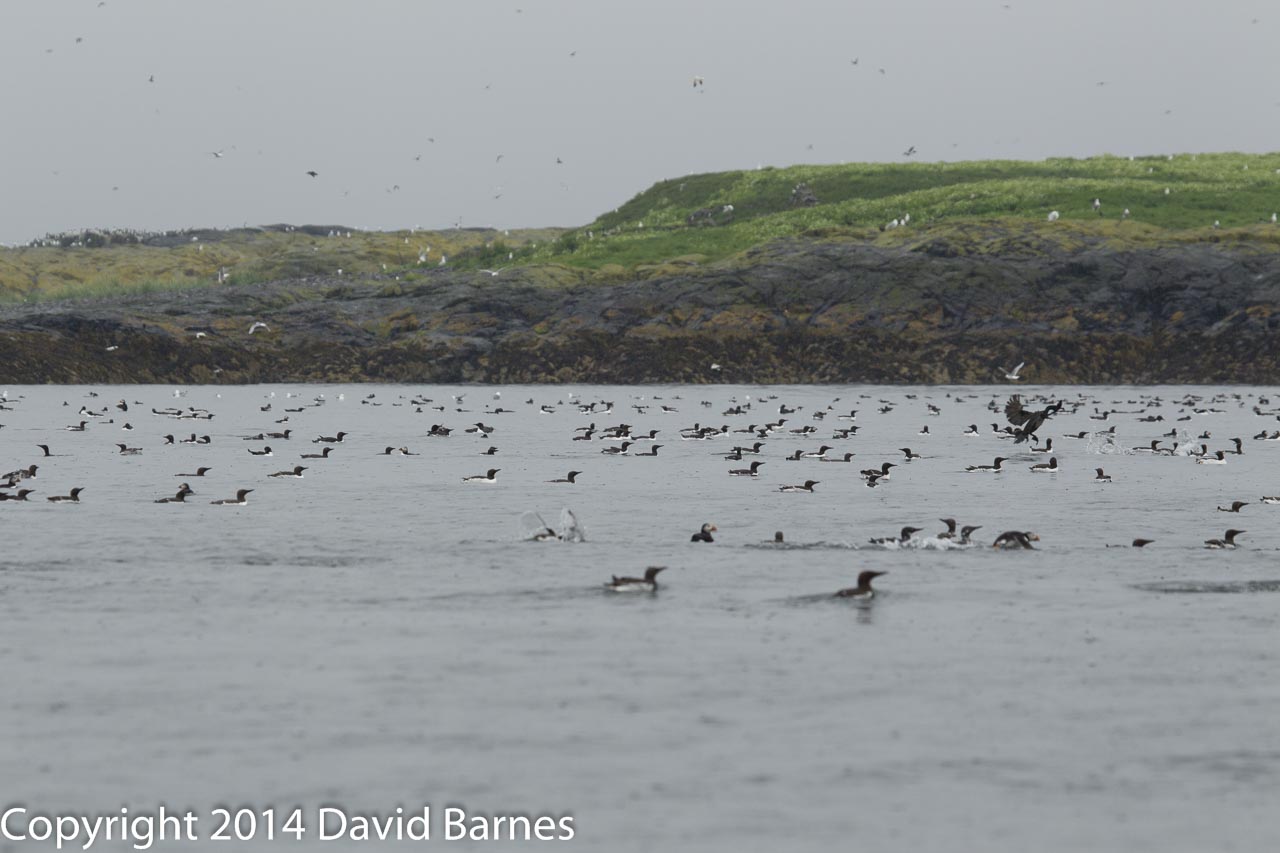 |
| A busy morning around the Farnes! |
 |
| Cormorant preening in the rain. |
 |
| Kittiwakes pair bonding. |
 |
| The male Kittiwake brings in some more nest material. |
 |
| Shag on the nest in the rain |
 |
| Relaxed Shag |
 |
| Shag head detail |
 |
| "You looking at me" |
 |
| "I've got my eye on you" |
 |
| Mating Lesser Black-backed Gulls |
 |
| A Puffin departs after feeding it's young in the burrow. |
 |
| Atlantic Puffin in flight with a beak full of Sand Eels |
 |
| Atlantic Puffin in flight with a beak full of Sand Eels |
There wasn't a lot to add from Inner Farne this time. I didn't go too mad with the Arctic Terns this time as I had loads from the first trip and the conditions were worse this time. I felt it was better to leave them alone and let them stay on their nests as much as possible as it was cooler today. In fact we were fortunate to get on Inner Farne, if the heavy rain had continued the rangers would most likely have closed Inner Farne to landings so the Terns didn't get disturbed.
This young Grey Seal was laid up on the beach by the landing point.
 |
| Young Atlantic Grey Seal |
 |
| Shag sleeping on decorated nest. |
One species I really neglected was the Sandwich Terns which also nest on Inner Farne. I didn't find the small colony to be ideally placed for photography but did eventually get this guy in flight as we waited for the boat.
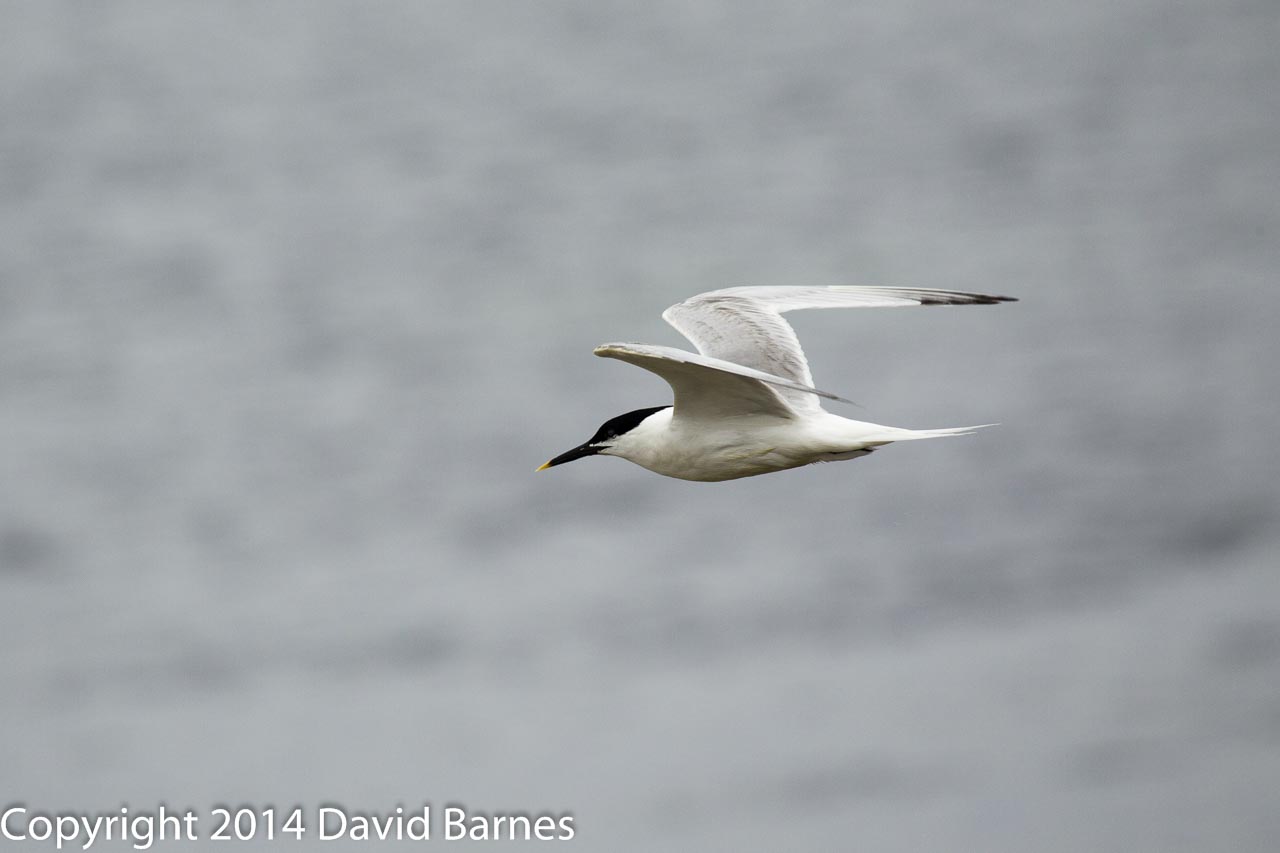 |
| Sandwich Tern in flight. |
And finally our last look back at the lighthouse on Inner Farne as we headed back to Seahouses.
 |
| The lighthouse on Inner Farne. |
Wednesday 18 June 2014
Farne Islands: Part 1 (02/06/2014)
My recent trip to Northumberland included 2 days out on the Farne Islands with Billy Shiel's Boat Trips. They are the only company that do the full day trip landing on Staple Island and Inner Farne for approx 2 hours each. They also take you around the islands checking out the Grey Seals, conditions permitting. Don't forget to take into account the cost of getting on the islands when budgeting. The boat trip does not include this, they do tell you though. National Trust members get on the islands for free.
I pre-booked my trips but you can also take your chance and just turn up on the day. If the weather is not very favourable then you stand a good chance of getting a place, but there is also a chance that the trip may be cancelled. When the Terns are on eggs the rangers sometimes close Inner Farne to allow the birds to remain on the nests. As most will know when you go onto Inner Farne the Terns get up off their nests and attack visitors which leaves their eggs open to the elements. If it rains all day then there is a reasonable chance that the rangers will close Inner Farne to prevent the eggs getting cols while the Terns are off attacking visitors!
Despite a poor forecast the first day out didn't turn out too bad, mainly overcast with the odd light shower. The boat was pretty full but I managed to get a seat along the side near the back, hopefully allowing for good photo opportunities. It doesn't really matter what side of the boat you are on as the skipper does his best to give everyone good views of the birds and seals around the islands. I went with my 100-400mm zoom lens for the day, you will almost certainly want a long lens on the boat but a shorter option is useful on the islands as you will be able to get extremely close to some of the inhabitants!
The first landing is Staple Island. You will be walking over rocks which become very slippery when wet so make sure you have good grip on your boots. There are great opportunities for photographing Puffins and Shags here. Guillemots, Kittiwakes and a few Fulmars along with the marauding Gulls were also good subjects but I focussed on the Puffins and the Shags. In fact I couldn't believe my luck when the first bird I saw, having got off the boat and paid my dues, was this Puffin.
The light wasn't ideal but I quite like the way it lights up the beak from behind. I was hoping for this type of shot when I booked the trip but to get it within a few minutes of stepping ashore was fantastic.
Quite a bit of Staple Island is open to roam as you please but the nesting areas are roped off so I spent a bit of time have a look around to see what was around and where I might get some good shots. There were plenty of Shags close to the edge of the roped off area making for some nice close ups. I love the green eye and way the feathers look like scales. These birds have a real prehistoric look to them but they are so confiding when you are up close to them.
There are several Gull species around the islands with Kittiwakes the most numerous, nesting on the small cliffs alongside the Guillemots, Razorbills and Shags. The Black-headed gulls are probably the second most numerous followed by Lesser Black-backed and Herring Gulls. Then there are a few Great Black-backed Gulls. All of the these species seem to rely on robbing the other birds of the food they bring back or stealing eggs and chicks left unguarded.
On Staple Island there are mostly LBB and Herring Gulls with the BH Gulls mostly congregating on Inner Farne. I watched them robbing Puffins of their Sand Eels as they arrived back at the nest burrows. The Puffins tried their best to drop right in their holes to avoid being robbed but any small mistake resulted in a desperate run to get to the burrow, sometimes any burrow, to avoid the attentions of the Gulls.
I spent a lot of time on Staple Island trying to capture Puffins in flight, especially those bringing in Sand Eels. I got a few shots but wasn't particularly happy with the results. Here are a selection of images.
Had to crop most of those to some extent which was a bit disappointing given how close some of them came. I'll just have to go back and have another go.
Just before we left Staple island I found this chap which book ended the stop nicely.
We had a quick cruise around the Grey Seal colony before moving on to Inner Farne in the afternoon.
Then it was on to Inner Farne, most famous for its Arctic Terns attacking visitors as they pass through the nesting areas on the island. Inner Farne is much more restricted in where you can walk with basically just a roped off path around the island. It doesn't take long to walk around the island so I suggest you do that to check out where the best photo opportunities are. This means you will also move quickly through the Terns causing them less disturbance. It often gets clogged up with people here anyway as everyone tries to photograph the Terns so not a bad thing to move on quickly and come back to it later on. The best areas for me were the cliffs up by the lighthouse and, of course, the Terns back at the start.
Look out for the times when all of the Terns get up to see off an intruder. In this case a Great Black-backed Gull arrived in the middle of the colony and the call to arms went up! It's quite a spectacle
It was quite busy on the cliffs as well!
The Black-headed Gulls nest on Inner Farne and are much more numerous here, harassing the Puffins as they come back in to feed their young.
At the cliffs adjacent to the lighthouse there are good photo opportunities with the Kittiwakes, Razorbills, Guillemots and Shags.
So that was it for the first trip out to the islands and it was back on the boat and back to the harbour in Seahouses to start sorting through the hundreds of images. What a great day out.
By the way make sure you take time to have a chat to the rangers. They have amazing knowledge of the islands and know exactly what is going on with all of the birds. What a great job they are doing out there.
Information and links:
William Shiel (@thefarneislands)
Boat Trips to the Farne Islands from Seahouses harbour. Sailings available all year round.
Seahouses, Northumberland. http://www.farne-islands.com
@NTsteely Farne Islands Blog: http://farnephoto.blogspot.co.uk/
I pre-booked my trips but you can also take your chance and just turn up on the day. If the weather is not very favourable then you stand a good chance of getting a place, but there is also a chance that the trip may be cancelled. When the Terns are on eggs the rangers sometimes close Inner Farne to allow the birds to remain on the nests. As most will know when you go onto Inner Farne the Terns get up off their nests and attack visitors which leaves their eggs open to the elements. If it rains all day then there is a reasonable chance that the rangers will close Inner Farne to prevent the eggs getting cols while the Terns are off attacking visitors!
 |
| Heading out past Inner Farne |
 |
| Guillemots on Inner Farne |
 |
| Kittiwake having a bath |
 |
| Shag out fishing |
The first landing is Staple Island. You will be walking over rocks which become very slippery when wet so make sure you have good grip on your boots. There are great opportunities for photographing Puffins and Shags here. Guillemots, Kittiwakes and a few Fulmars along with the marauding Gulls were also good subjects but I focussed on the Puffins and the Shags. In fact I couldn't believe my luck when the first bird I saw, having got off the boat and paid my dues, was this Puffin.
 |
| Puffin with Sand Eels |
The light wasn't ideal but I quite like the way it lights up the beak from behind. I was hoping for this type of shot when I booked the trip but to get it within a few minutes of stepping ashore was fantastic.
Quite a bit of Staple Island is open to roam as you please but the nesting areas are roped off so I spent a bit of time have a look around to see what was around and where I might get some good shots. There were plenty of Shags close to the edge of the roped off area making for some nice close ups. I love the green eye and way the feathers look like scales. These birds have a real prehistoric look to them but they are so confiding when you are up close to them.
 |
| Shag (Portrait) |
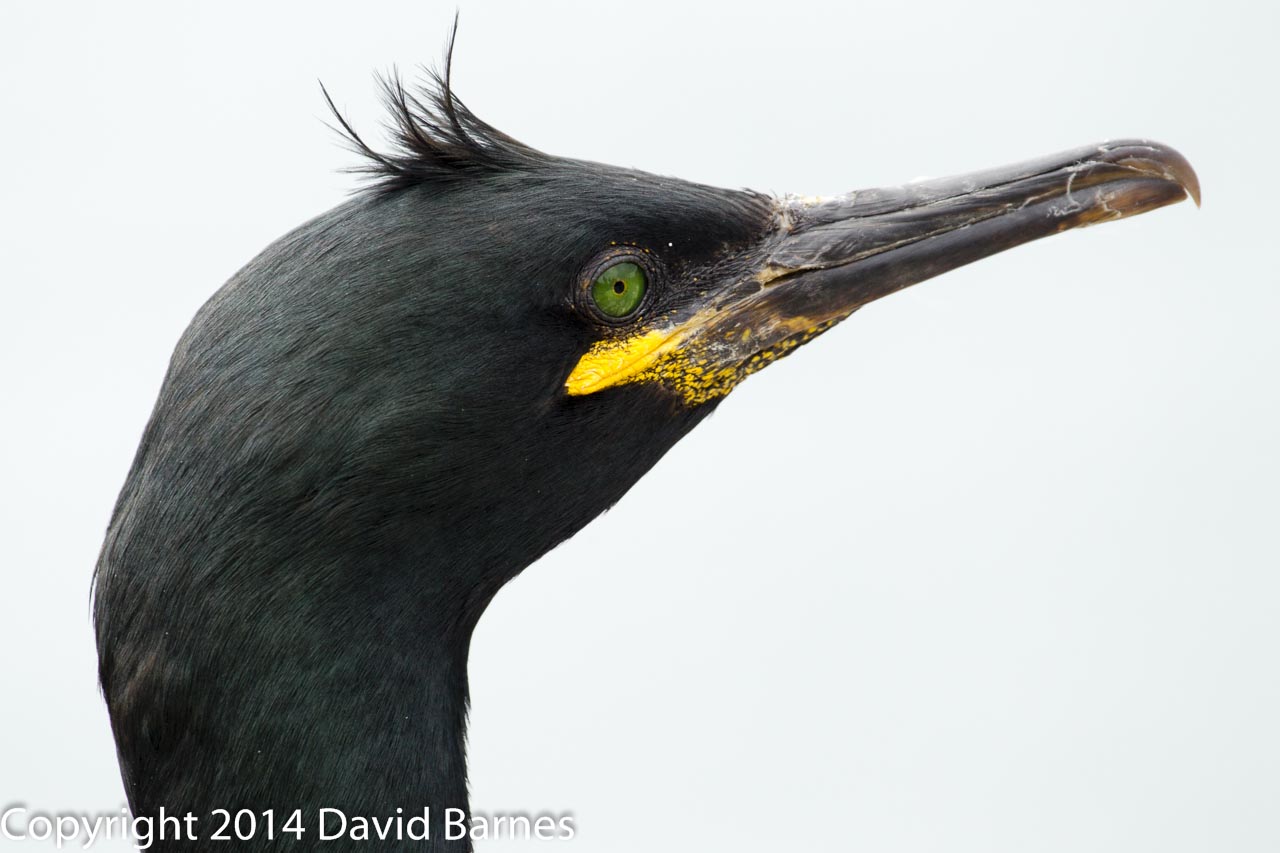 |
| Shag (Portrait) |
 |
| Shag at rest ("still keeping an eye on you") |
 |
| Lesser Black-backed Gull stalking the Puffin nesting grounds. |
 | |
|
I spent a lot of time on Staple Island trying to capture Puffins in flight, especially those bringing in Sand Eels. I got a few shots but wasn't particularly happy with the results. Here are a selection of images.
Had to crop most of those to some extent which was a bit disappointing given how close some of them came. I'll just have to go back and have another go.
Just before we left Staple island I found this chap which book ended the stop nicely.
 |
| Atlantic Puffin with Sand Eels |
 |
| Grey Seal resting on the rocks |
 |
| Arctic Tern (mono) |
 |
| Arctic Tern coming in to attack |
 |
| Arctic Tern on a fence post |
 |
| Ground nesting Arctic Tern |
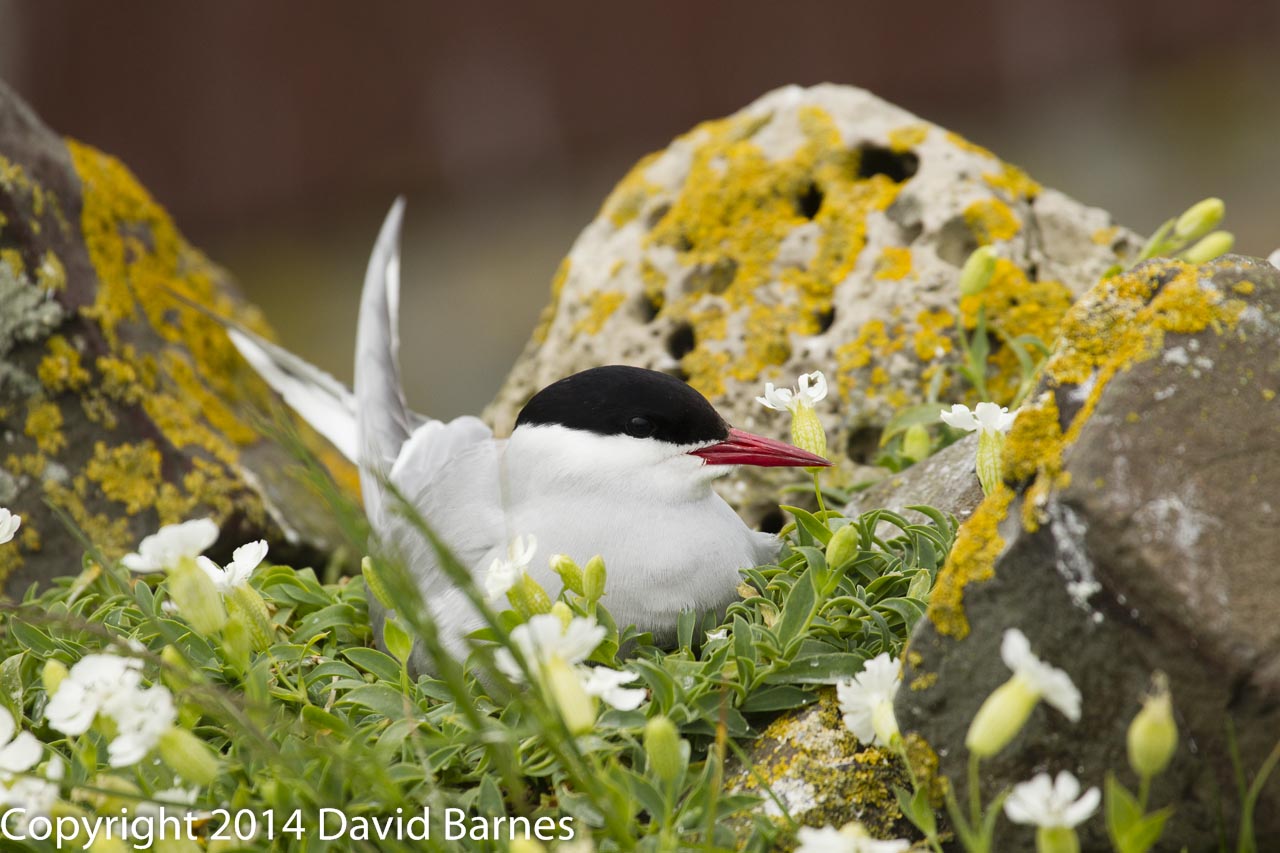 |
| Arctic Tern nesting on a dry stone wall |
 |
| Arctic Tern on lichen covered rocks |
 |
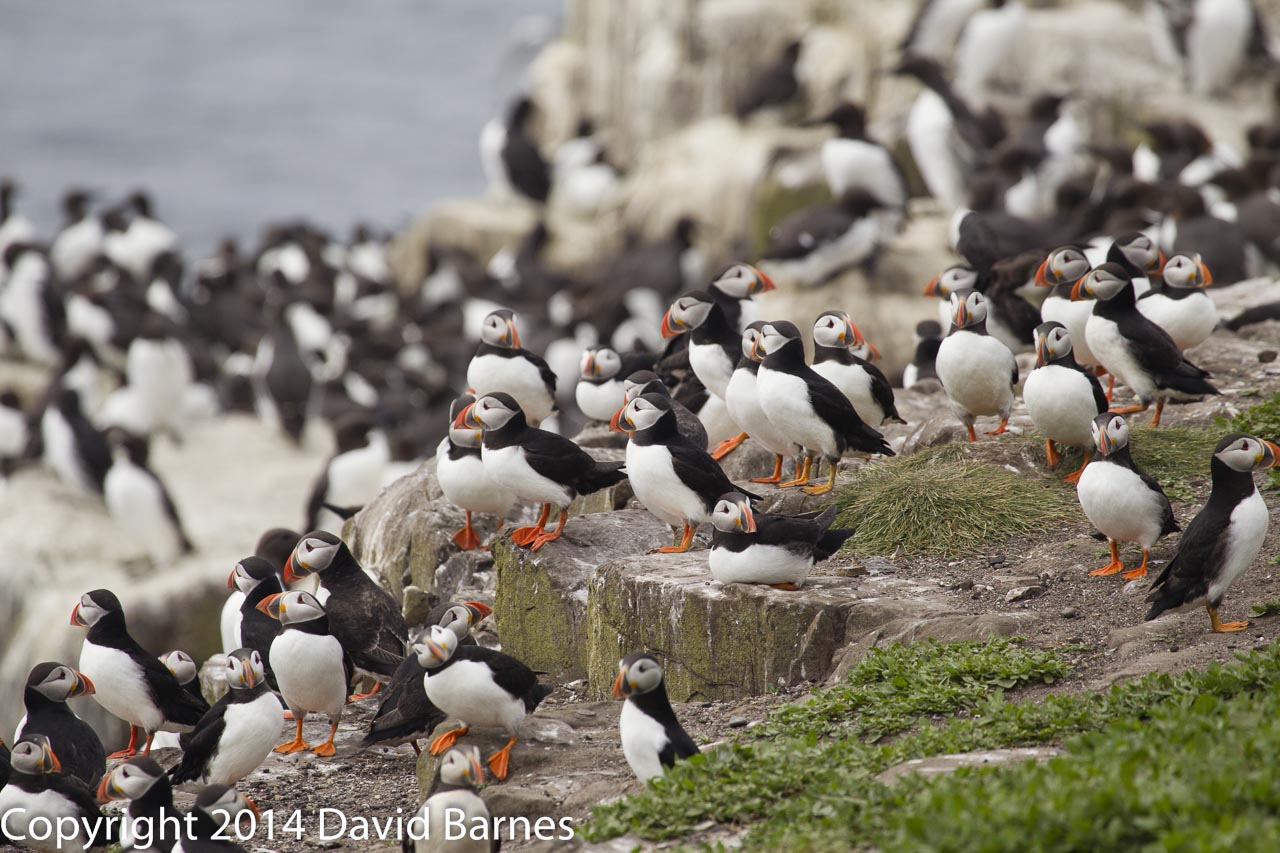 |
| Puffins congregate on the rocks before heading out to sea. |
 |
| Puffin portrait |
 |
| Black-headed Gull waits by the Puffin burrows. |
The LBB and Herring Gulls are ever present waiting for an opportunity to steal some fish.
 |
| Lesser Black-backed Gull keeps an eye out for the Puffin food delivery service! |
 |
| Kittiwake hovers on the updraught by the cliff face. |
 | |
|
 |
| A pair of Razorbills |
By the way make sure you take time to have a chat to the rangers. They have amazing knowledge of the islands and know exactly what is going on with all of the birds. What a great job they are doing out there.
Information and links:
William Shiel (@thefarneislands)
Boat Trips to the Farne Islands from Seahouses harbour. Sailings available all year round.
Seahouses, Northumberland. http://www.farne-islands.com
@NTsteely Farne Islands Blog: http://farnephoto.blogspot.co.uk/
Subscribe to:
Posts (Atom)




